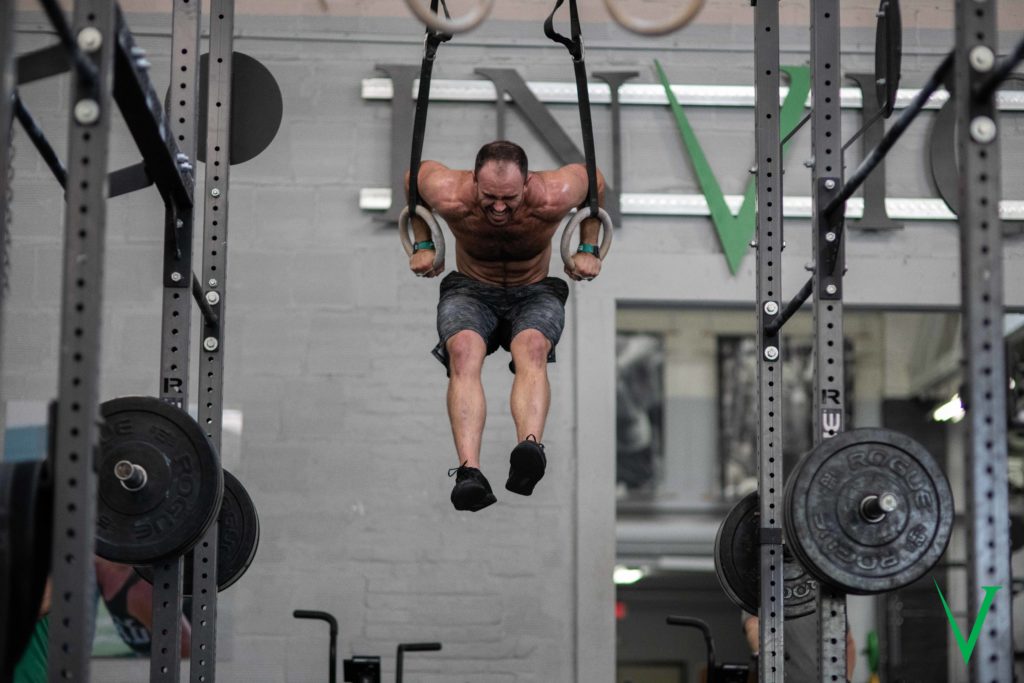 How to Spot a Kipping Ring Muscle-Up
How to Spot a Kipping Ring Muscle-Up
Written by Kaitlyn Kassis
This drill is the closest progression there is to doing an actual kipping ring muscle-up as you can get. It is necessary to possess sufficient upper-body pulling and pressing capacity, as well as have previous experience with muscle-up transition drills on low-rings before attempting this more advanced progression.
Pre-Requisites for Kipping Ring Muscle-Ups
It is recommended that you are able to complete at least 5+ unbroken strict pull-ups and dips, in addition to being able to support yourself in the top and bottom of a dip position on rings for 15+ seconds. A proper and efficient kip on the rings is an essential skill to possess before attempting this drill, as the assistance will only be provided through the hip drive and/or transition phase of the muscle-up.
The Role of the Spotter for the Kipping Ring Muscle-Up
The role of the spotter is to provide a “boost” through the transition portion of the muscle-up in order to help the athlete get up and over the rings. The spotter’s assistance in this drill begins when the athlete’s hips begin to travel in an upward motion after passing through the hollow position of the kip. A hand will be placed on the athlete’s low back – once the upward momentum is initiated – in order to guide the hips of the athlete toward the rings. However, with this drill, there are a few variables that can be changed in order to increase/decrease the amount of assistance from the spotter.
Levels of Assistance from the Spotter on a Kipping Ring Muscle-Up
Least Amount of Spotter Assistance – The least assistance can be provided with a quick and gentle push in an upward motion on the athlete’s lower back immediately after the hollow position of the kip. The athlete will complete the hip drive and transition entirely on their own after the “boost” from the spotter. This progression is awesome for athletes who are super close to getting a ring muscle-up but maybe struggle with feeling the importance of pushing the hips up toward the rings.
Medium Amount of Spotter Assistance – Medium assistance in this drill can be provided through guiding the athlete’s hips up to the rings with the same motion as mentioned previously, but the spotter will keep the hand on the lower back of the athlete throughout the entire hip drive. The spotter will then allow the athlete to complete the transition on their own.
Greatest Amount of Spotter Assistance – The most assistance on this drill can be provided by guiding the athlete’s hips up to the rings through the entire hip drive, as well as placing the opposite hand on the athlete’s hamstring through the transition of the muscle-up. This is great for athletes who have a tendency to pull the rings to their chest, as opposed to pushing their hips to the rings. The spotter can guide the hips to the proper position, and then help the athlete find the ideal upward momentum and rotation over the rings. The spotter can also keep a hand on the athlete’s hamstring to give assistance through the dip out of the transition as well. This helps to build confidence in the athlete’s ring stability, and peace of mind if the athlete is worried about over-rotation.
Spotters take your roles seriously! You are both the missing link (strength or techniquewise) and also a boost of confidence for the athlete who is attempting the muscle-up. Their success in this drill and toward an unassisted muscle-up is largely in your hands!
